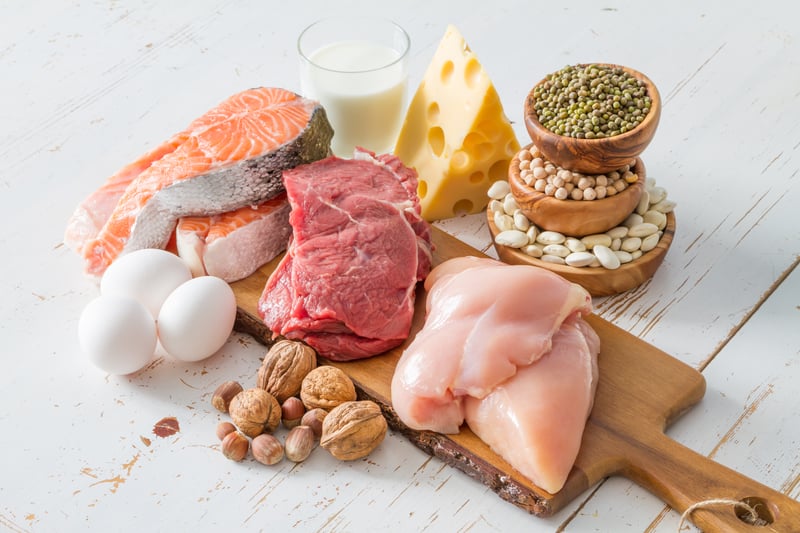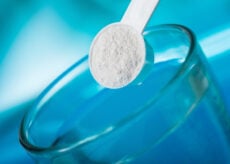How to Eat More Protein Everyday (10 Easy Tips)

If you’ve been reading this blog for any length of time, you may have noticed that all of our coaches recommend eating a higher protein diet. And for good reason! Eating a higher protein diet can boost metabolism, reduce appetite, enhance quality weight loss, and more!
But consuming protein in the neighborhood of 1.6 grams/kg/day (or, roughly 0.75 grams per pound for those of us Americans) might seem like a daunting challenge, especially if you’ve been eating a typical Western-style diet (i.e., “fast-food” diet). After all, that’s 110 grams of protein for someone who weighs around 150 pounds. That’s a lot of chicken breasts!
Fortunately, we have your back—and your front—and are here to make sure you know how you can easily eat more protein, which we know is so beneficial. Here are 10 simple ways to increase protein intake.
10 Easy Ways to Eat More Protein
- Start your day out right. If you’re like most people, you start your day out with convenience “foods”, like cereal or a granola bar, for breakfast. But, by switching to eggs (12 grams of protein in 2 eggs) or a high-quality protein shake (24 grams of protein in each BioTrust Low Carb smoothie), you’ll start out on a better start to eat more protein.
- Make it creamy. Another easy way to eat more protein is by adding a dollop of delicious creaminess to your diet—in the form of Greek yogurt, that is. Plain Greek yogurt not only fills your belly with appetite-satisfying protein (20 grams of protein goodness in each 1-cup serving), it’s also packed with gut-nourishing probiotics. You can use Greek yogurt any time you would typically use regular yogurt or sour cream.
- Snack on seeds. Seeds are good plant-based source of protein, and they are typically packaged with healthy fats, fiber, and key vitamins and minerals to boot. Take hemp seeds (aka hemp hearts) for example. A tablespoon provides 5 grams of protein only 40 calories. You’ll also find 5 grams of protein in a tablespoon of chia seeds. And pumpkin seeds pack 5 grams of protein per ounce as well. These seeds are clearly not for the birds.
- Go nuts. Nuts are another quality plant-based source of protein, not to mention healthy fats, vitamins, minerals, and antioxidants. However, because nuts calorie dense, we suggest enjoying them within reason. So, while it’s easy to eat an entire bag of nuts, go slow and savor a small handful of these delicious protein sources (so you don’t pack in too many calories).
- Stock up on beans and legumes. Beans and legumes, like lentils, make it super-easy to eat more protein and fiber as to boot. Plus, they’re inexpensive and so dang versatile. If you have a favorite soup recipe that calls for rice, noodles, or other grains, add lentils or split peas instead—the result is a fantastic texture a boost in nutrition that can’t be beat.
- Choose your grains wisely. Not all grains are created equally, and some have significantly higher amounts of protein. Let’s look at quinoa (14 grams of protein per ounce) and barley (12g/oz.), for example. On the other hand, look at brown rice and couscous, which contain a comparatively paltry 3 grams of protein per ounce. In many recipes, different grains can be substituted, so give the higher protein options a try and see if you even notice a difference.
- Slather your sandwich. Think you need to slather on the mayo for a perfect sandwich? Try hummus instead. It provides flavor, fiber, creaminess, and it’s a sneaky way to increase protein intake. Each tablespoon adds 1 gram of protein and only 25 calories. Compare that to NO and the 90 calories you’ll get from a single tablespoon of mayo.
- Look beyond the cheese. Like most dairy, cheese is a good, high-quality source of protein, but like nuts, it’s important to watch portion sizes as calories can start to add up quickly. So, if you’re looking for that “cheesy” flavor and the protein but not quite as many calories, consider nutritional yeast. It goes great on top of salads, air-popped popcorn, and even as a replacement for Parmesan cheese on your Italian dishes. Each ¼-cup serving adds 9 grams of protein and 4 grams of fiber along with several B vitamins and only 60 calories. Compare that to a ¼-cup serving of Parmesan cheese, which has a similar amount of protein (10 grams) but 114 calories.
- It’s good to be green. Green peas are packed with a burst of full flavor in every little ball, but that’s not all. A one-cup serving also provides 8 grams of protein. While peas are admittedly not a vegetable (they’re part of the legume family), there are numerous vegetables that provide quality protein, so load up your plate with higher protein vegetables like spinach, broccoli, and asparagus.
- Don’t forget meat (and fish). If you’re a plant-based eater, then you can skip this one… If not, then you may have been wondering when I was going to get to the meat of the issue. ???? Of course, meat, fish, and poultry are among the best sources of high-quality protein. A 3-ounce (cooked) portion of white meat chicken or turkey supplies around 25 grams of protein, while a similar portion of lean ground beef offers 22 grams (and a ton of other important nutrients). Meanwhile, 3 ounces of tuna will load you up with 25 grams of protein, and a 3-ounce portion of cooked salmon provides 17 grams of protein (not to mention a hefty dose of healthy fats, vitamin D, and several other essential vitamins and minerals). A can of sardines and a 3-ounce serving of pork chops both deliver 23 grams.
When it comes to protein, there are so many simple options. Choosing one grain over another, adding some legumes or seeds to a salad, making a healthier snack choice, or substituting a high-quality protein shake for a convenient junk food can dramatically increase protein intake (and diet quality) without any extra time and effort. Now that you know many foods and ways to eat more protein, it’s just about making those choices and enjoying all of the benefits that protein provides!






